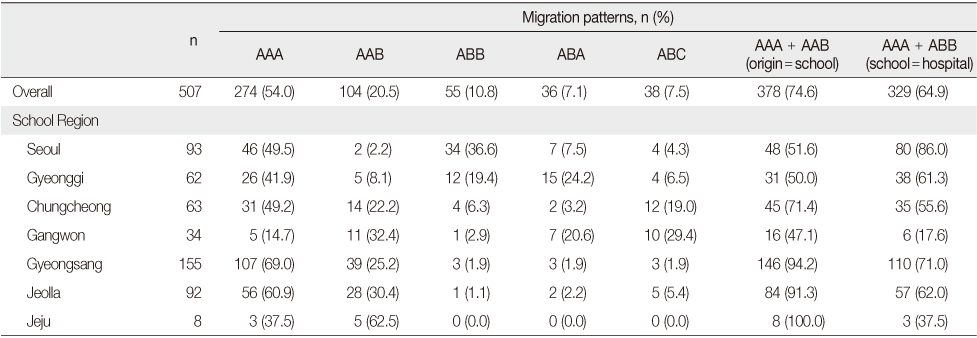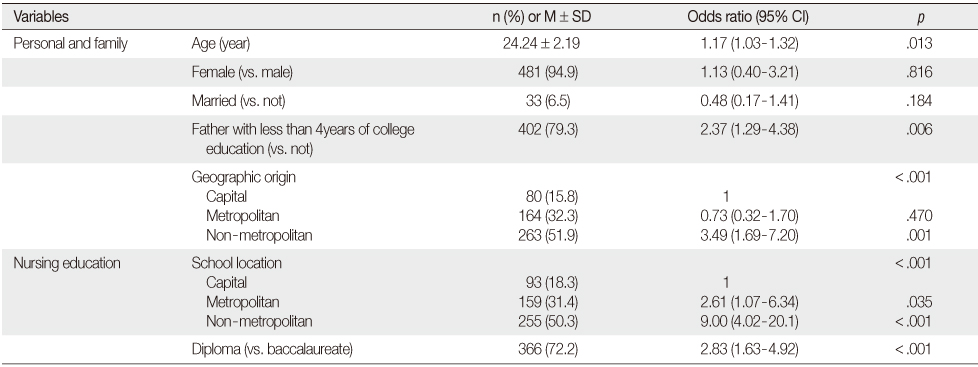Articles
- Page Path
- HOME > J Korean Acad Nurs > Volume 42(7); 2012 > Article
-
Original Article
- Geographical Imbalances: Migration Patterns of New Graduate Nurses and Factors Related to Working in Non-Metropolitan Hospitals
- Sung-Hyun Cho, Ji Yun Lee, Barbara A. Mark, Han Yi Lee
-
Journal of Korean Academy of Nursing 2012;42(7):1019-1026.
DOI: https://doi.org/10.4040/jkan.2012.42.7.1019
Published online: December 31, 2012
1College of Nursing, Research Institute of Nursing Science, Seoul National University, Seoul, Korea.
2Department of Nursing, Kangwon National University, Chuncheon, Korea.
3School of Nursing, University of North Carolina at Chapel Hill, NC, USA.
4Department of Nursing, Hanyang University, Seoul, Korea.
- Address reprint requests to: Cho, Sung-Hyun. College of Nursing, Research Institute of Nursing Science, Seoul National University, 28 Yeongeon-dong, Chongro-gu, Seoul 110-799, Korea. Tel: + 82-2-740-8821, Fax: + 82-2-765-4103, sunghcho@snu.ac.kr
© 2012 Korean Society of Nursing Science
- 982 Views
- 4 Download
- 16 Crossref
Abstract
-
Purpose
- To examine geographical imbalances by analyzing new graduate nurses' migration patterns among regions where they grew up, attended nursing school, and had their first employment and to identify factors related to working in non-metropolitan areas.
-
Methods
- The sample consisted of 507 new graduates working in hospitals as full-time registered nurses in South Korea. Migration patterns were categorized into 5 patterns based on sequential transitions of "geographic origin-nursing school-hospital." Multiple logistic regression analysis was conducted to identify factors associated with working in non-metropolitan hospitals.
-
Results
- Nurses who grew up, graduated, and worked in the same region accounted for the greatest proportion (54%). Sixty-five percent had their first employment in the region where they graduated. Nurses tended to move from poor to rich regions and from non-metropolitan to metropolitan areas. Working in non-metropolitan hospitals was related to older age, the father having completed less than 4 years of college education, non-metropolitan origin, non-capital city school graduation, and a diploma (vs. baccalaureate) degree.
-
Conclusion
- Admitting students with rural backgrounds, increasing rural nursing school admission capacities, and providing service-requiring scholarships, particularly for students from low-income families, are recommended to address geographical imbalances.
INTRODUCTION
METHODS
1) Regions of origin, nursing school, and hospital
2) Migration patterns
AAA (origin=school=hospital): the individual grew up, graduated, and had the first employment in the same region.
AAB (origin=school≠hospital): the individual grew up and graduated in the same region then moved to another region for the first employment.
ABB (origin≠school=hospital): the individual left the region of origin to study nursing and stayed in the new region for the first employment.
ABA (origin≠school, and origin=hospital): the individual left the region of origin to study but returned back to this region for the first employment.
ABC (origin≠school, school≠hospital, and origin≠hospital): all three regions were different.
3) A net gain or loss from migration
4) Poor versus rich regions
5) Rural versus urban areas
6) Factors associated with working in non-metropolitan hospitals
RESULTS
DISCUSSION
CONCLUSION
- 1. Bushy A, Leipert B. Factors that influence students in choosing rural nursing practice: A pilot study. Rural Remote Health. 2005;5(2):387. Retrieved July 5, 2011, from http://www.rrh.org.au.PubMed
- 2. Cho EM. Nurse shortage. [Munhwa Broadcasting Corporation TV news]. 2011;01 19 Retrieved February 22, 2011. from http://imnews.imbc.com/replay/nwdesk/article/2781384_5780.html.
- 3. Chung KS. Advancing nursing education and practice. The Korean Nurses Association News. 2009;10 29 1–2.
- 4. Dayrit MM, Dolea C, Braichet JM. One piece of the puzzle to solve the human resources for health crisis. Bull World Health Organ. 2010;88:322. http://dx.doi.org/10.2471/BLT.10.078485.ArticlePubMedPMC
- 5. Dussault G, Franceschini MC. Not enough there, too many here: Understanding geographical imbalances in the distribution of the health workforce. Hum Resour Health. 2006;4:12. http://dx.doi.org/10.1186/1478-4491-4-12.PubMedPMC
- 6. Grobler L, Marais BJ, Mabunda SA, Marindi PN, Reuter H, Volmink J. Interventions for increasing the proportion of health professionals practising in rural and other underserved areas. Cochrane Database Syst Rev. 2009;http://dx.doi.org/10.1002/14651858.CD005314.pub2.
- 7. Hegney D, McCarthy A, Rogers-Clark C, Gorman D. Why nurses are attracted to rural and remote practice. Aust J Rural Health. 2002;10:178–186. http://dx.doi.org/10.1046/j.1440-1584.2002. 00447.x.ArticlePubMed
- 8. Henderson LN, Tulloch J. Incentives for retaining and motivating health workers in Pacific and Asian countries. Hum Resour Health. 2008;6:18. http://dx.doi.org/10.1186/1478-4491-6-18.PubMedPMC
- 9. Korea Employment Information Service. 2007 Graduates occupational mobility survey user's guide. 2009;Seoul, Author.
- 10. Korean Council for University Education. College admission information. 2012;Retrieved February 1, 2012. from http://univ.kcue.or.kr.
- 11. Korean Nurses Association. 2007 Yearbook of nursing statistics. 2007;Seoul, Author.
- 12. Lea J, Cruickshank M. Factors that influence the recruitment and retention of graduate nurses in rural health care facilities. Collegian. 2005;12(2):22–27. http://dx.doi.org/10.1016/S1322-7696(08)60489-8.Article
- 13. Ministry of Health & Welfare. Health statistics. 2012;Retrieved July 6, 2012. from http://stat.mw.go.kr/.
- 14. Playford D, Wheatland B, Larson A. Does teaching an entire nursing degree rurally have more workforce impact than rural placements? Contemp Nurse. 2010;35:68–76. http://dx.doi.org/10.5172/conu.2010.35.1.068.ArticlePubMed
- 15. Robinson S, Murrells T, Griffiths P. Investigating the dynamics of nurse migration in early career: A longitudinal questionnaire survey of variation in regional retention of diploma qualifiers in England. Int J Nurs Stud. 2008;45:1064–1080. http://dx.doi.org/10.1016/j.ijnurstu.2007.07.001.ArticlePubMed
- 16. Serneels P, Lindelow M, Montalvo JG, Barr A. For public service or money: Understanding geographical imbalances in the health workforce. Health Policy Plan. 2007;22:128–138. http://dx.doi.org/10.1093/heapol/czm005.ArticlePubMed
- 17. Statistics Korea. e-National indicators. 2012;Retrieved February 1, 2012. from http://www.index.go.kr.
- 18. Wilkinson D, Beilby JJ, Thompson DJ, Laven GA, Chamberlain NL, Laurence CO. Associations between rural background and where south Australian general practitioners work. Med J Aust. 2000;173:137–140.ArticlePubMedPDF
- 19. Wilson NW, Couper ID, De Vries E, Reid S, Fish T, Marais BJ. A critical review of interventions to redress the inequitable distribution of healthcare professionals to rural and remote areas. Rural Remote Health. 2009;9(2):1060. Retrieved July 1, 2011, from http://www.rrh.org.au.PubMed
- 20. Wood D. Effects of educational focus on a graduate nurse's initial choice of practice area. J Prof Nurs. 1998;14:214–219. http://dx.doi.org/10.1016/S8755-7223(98)80061-6.ArticlePubMed
- 21. World Health Organization. Increasing access to health workers in remote and rural areas through improved retention: Global policy recommendations. 2010;Geneva, Switzerland, Author.
- 22. Yoo SJ, Choi YH. Predictive factors influencing turnover intention of nurses in small and medium-sized hospitals in Daegu City. J Korean Acad Nurs Adm. 2009;15:16–25.
- 23. Zurn P, Dal Poz MR, Stilwell B, Adams O. Imbalance in the health workforce. Hum Resour Health. 2004;2:13. http://dx.doi.org/10.1186/1478-4491-2-13.PubMedPMC
REFERENCES


*Empty cells indicate no case; †A net gain or loss refers to the sum of a gain and a loss of graduates in each region; the percent indicates the net gain or loss divided by the total number of graduates; ‡GRDP refers to gross regional domestic product and the ranks of 7 regions were consistent across years of 2005, 2006, and 2007; §Proportions of hospital beds as of 2007.
Figure & Data
REFERENCES
Citations

- Empirical Analysis of Geographic Inequalities in the Distribution of Nurses
Euntae Park, Jinhyun Kim
Journal of Korean Academy of Nursing Administration.2024; 30(3): 271. CrossRef - Job change among early career nurses and related factors: A postgraduation 4‐year follow‐up study
Eun‐Young Kim, Sun‐Hee Kim
Journal of Nursing Management.2022; 30(7): 3083. CrossRef - Turnover Rates and Factors Influencing Turnover of Korean Acute Care Hospital Nurses: A Retrospective Study Based on Survival Analysis
Bohyun Park, Yukyung Ko
Asian Nursing Research.2020; 14(5): 293. CrossRef - Factors Influencing Nursing Students' Choices of a Place of Employment
Sun Ju You, Jong Kyung Kim, Myun Sook Jung, Se Young Kim, Eun Kyung Kim
Korean Journal of Health Promotion.2018; 18(4): 184. CrossRef - Factors Associated with the Choices of Local Hospitals among New Graduate Nurses
Eun-Young Kim, Hun Ha Cho
Journal of Korean Academy of Nursing Administration.2018; 24(3): 202. CrossRef - Impact of Increased Supply of Newly Licensed Nurses on Hospital Nurse Staffing and Policy Implications
Yunmi Kim, Sunju You, Jinhyun Kim
Journal of Korean Academy of Nursing.2017; 47(6): 828. CrossRef - Geographic Mobility and Related Factors among Newly Graduated Nurses
Hyo Jeong Yoon, Sung Hyun Cho
Journal of Korean Academic Society of Nursing Education.2017; 23(3): 353. CrossRef - Patterns and Influential Factors of Inter-Regional Migration of New and Experienced Nurses in 2011~2015
Bohyun Park, Se Young Kim
Journal of Korean Academy of Nursing.2017; 47(5): 676. CrossRef - A final-year nursing student survey: rural attitudes, perceived competencies and intention to work across five Asian countries
Nareerut Pudpong, Rapeepong Suphanchaimat, Bipin Batra, Jianlin Hou, Lan T. H. Vu, Paul Dipika
BMC Nursing.2017;[Epub] CrossRef - Predictors of Turnover among New Nurses using Multilevel Survival Analysis
Suhee Kim, Kyongeun Lee
Journal of Korean Academy of Nursing.2016; 46(5): 733. CrossRef - Factors influencing the intent to return to practice (work) of inactive RNs
Nami Hwang, Insun Jang, Eunjun Park
Journal of the Korean Data and Information Science Society.2016; 27(3): 791. CrossRef - Qualitative Research on Nurses Experiencing Taeoom
SunHwa Choeng, InSook Lee
Korean Journal of Occupational Health Nursing.2016; 25(3): 238. CrossRef - Impact of a financial incentive policy on Korean nurse staffing
Y. Kim, J. Kim
International Nursing Review.2015; 62(2): 171. CrossRef - Geographic mobility of Korean new graduate nurses from their first to subsequent jobs and metropolitan-nonmetropolitan differences in their job satisfaction
Sung-Hyun Cho, Ji Yun Lee, Barbara A. Mark, Cheryl B. Jones
Nursing Outlook.2014; 62(1): 22. CrossRef - Issues and Challenges of Nurse Workforce Policy: A Critical Review and Implication
Taewha Lee, Kyeong Hwa Kang, Yu Kyung Ko, Sung-Hyun Cho, Eun-Young Kim
Journal of Korean Academy of Nursing Administration.2014; 20(1): 106. CrossRef - Interventions for supporting nurse retention in rural and remote areas: an umbrella review
Gisèle Mbemba, Marie-Pierre Gagnon, Guy Paré, José Côté
Human Resources for Health.2013;[Epub] CrossRef
Migration Patterns among Regions of Origin, of Graduation, and of First Employment by School Region
AAA (origin=school=hospital); AAB (origin=school ≠ hospital); ABB (origin ≠ school=hospital); ABA (origin ≠ school, & origin=hospital) and ABC (origin ≠ school, school ≠ hospital, & origin ≠ hospital).
Migration from Schools to Hospitals by School Region
*Empty cells indicate no case; †A net gain or loss refers to the sum of a gain and a loss of graduates in each region; the percent indicates the net gain or loss divided by the total number of graduates; ‡GRDP refers to gross regional domestic product and the ranks of 7 regions were consistent across years of 2005, 2006, and 2007; §Proportions of hospital beds as of 2007.
Migration from Schools to Hospitals by Location
*A net gain or loss refers to the sum of a gain and a loss of graduates in each region; the percent indicates the net gain or loss divided by the total number of graduates.
Factors Associated with Working in Non-metropolitan Hospitals
AAA (origin=school=hospital); AAB (origin=school ≠ hospital); ABB (origin ≠ school=hospital); ABA (origin ≠ school, & origin=hospital) and ABC (origin ≠ school, school ≠ hospital, & origin ≠ hospital).
*Empty cells indicate no case; †A net gain or loss refers to the sum of a gain and a loss of graduates in each region; the percent indicates the net gain or loss divided by the total number of graduates; ‡GRDP refers to gross regional domestic product and the ranks of 7 regions were consistent across years of 2005, 2006, and 2007; §Proportions of hospital beds as of 2007.
*A net gain or loss refers to the sum of a gain and a loss of graduates in each region; the percent indicates the net gain or loss divided by the total number of graduates.
 KSNS
KSNS
 E-SUBMISSION
E-SUBMISSION


 Cite
Cite

